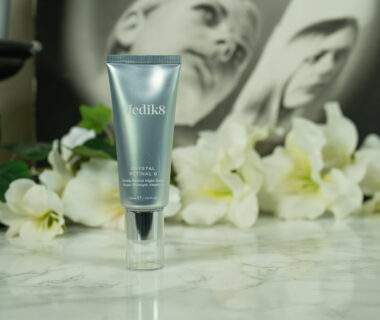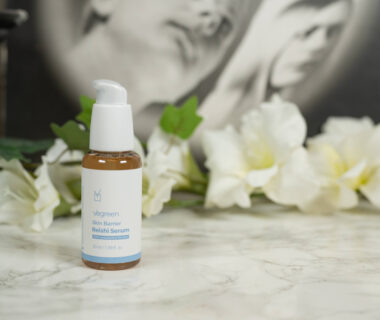ADVERTISEMENT INFO: SOME PRODUCTS MENTIONED IN THIS POST ARE PR (GIFTED) AND LINKS USED ARE AFFILIATE LINKS. I RECEIVED NO MONEY TO WRITE THE BLOGPOST. PLEASE READ DISCLAIMER
Hot flashes, mood swings… and sagging skin? What really happens to your face during menopause—and what can you actually do about it?
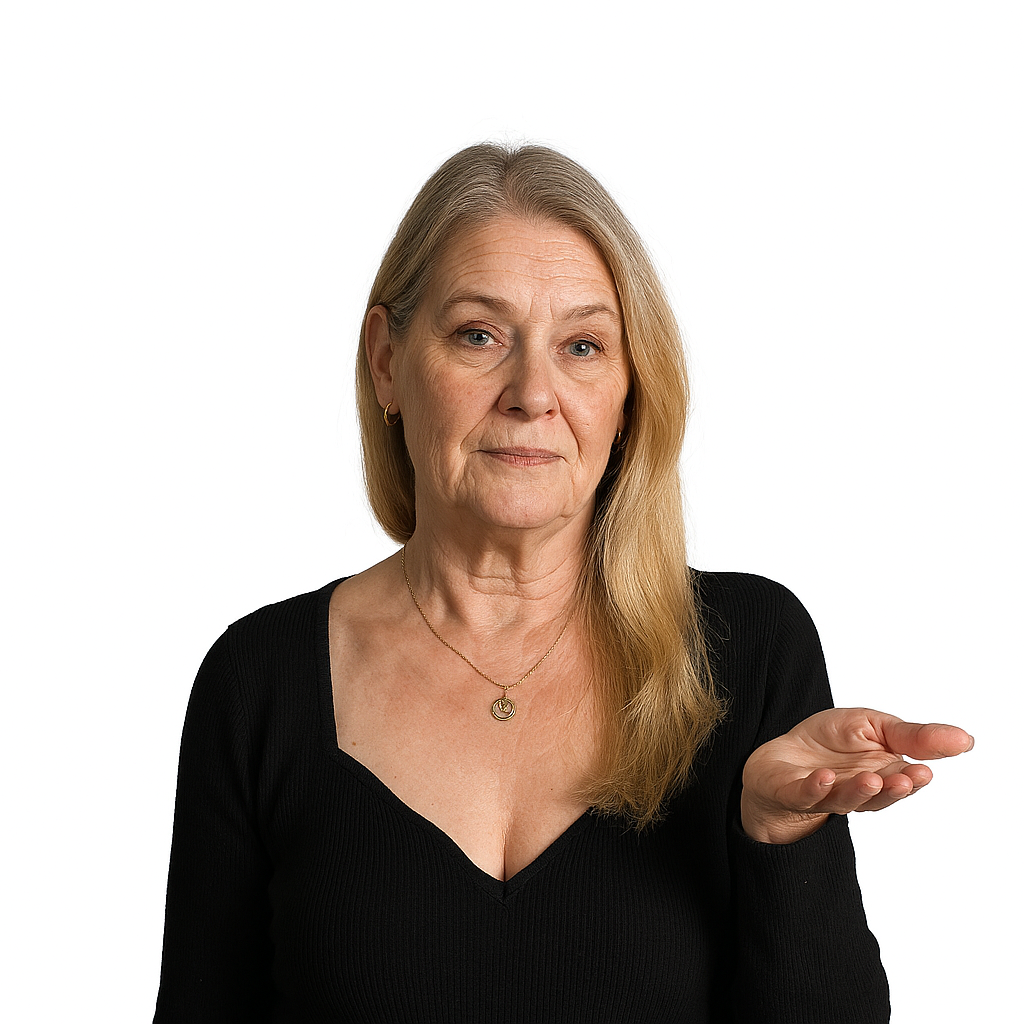
Spoiler: It’s not just about hormones. Today we’re separating facts from fear mongering and helping you take back control.
What is menopause, perimenopause, menopause transition and the menopause continuum?
When we talk about changes we expect, it is important that we all are on the same page about what we actually mean, so let’s start with defining the key terms here. These are not my definitions, I am referring to the book “The Menopause Manifesto” from Dr. Jen Gunter here, something I highly recommend you read – because knowledge is power.
Here is the timeline: We all come from reproductive age, enter the menopause transition where things start to get a little weird and then have our final menstrual period, which is menopause. After that we are in post menopause. The final menstrual period is defined as no more bleeding for at least 12 months, which is why you’ll only know you had it in hindsight. If for one year no more bleeding happens, that was the final period and we are officially 1 year in postmenopause. If after 11 months another period occurs, the countdown starts again – we were still in premenopause.
So strictly speaking, we don’t really have menopause skin changes, because that would only be a period of seven days on average, but skin changes in the time leading up to menopause and the time after menopause, so menopause transition and postmenopause or, combining both, the menopause continuum.
As that is quite confusing, for the sake of the post I will use menopause similar to menopause transition, including the period of premenopause, menopause and post menopause.
The duration of that menopause continuum can vary greatly between different people, just like the age at the actual final period it is influenced by genetics, environmental factors and lifestyle. An average number I have found is between two and eight years, but of course there is also medical or surgical menopause where there isn’t really a transition phase.

What happens during menopause?
During menopause, a lot happens with our hormones, but again we will keep it simple here: During the years leading up to the final menstrual period, the hormones are on a roller coaster, with levels sometimes being higher than usual and sometimes lower, and quite a few different hormones in different constellations are involved. For the skin, it is mainly the estrogen or, more specific, the estradiol we are interested in, as well as its relation to androgens.
With all the individual ups and downs, at the end of this transition, estrogen drops significantly. For some as steady decline over the years, for others in a short period of time. And that decline in estrogen levels triggers changes in the skin.

The effects of estrogen on the different skin layers
Our skin is made up of layers that have different functions:
- the epidermis is the outermost layer and has barrier function
- the dermis is home of collagen, elastin and the blood vessels and is responsible for bounce and firmness
- the subcutis is right underneath with the fat tissue for isolation.
All these layers are affected by estrogen and its decline.
In the epidermis, estrogen influences the proper proliferation and desquamation of the keratinocytes, so basically the process of new cells growing in and the old ones sloughing off as needed. It also influences the production of ceramides, both in terms of quantity as well as quantity. Ceramides are part of the lipid layer between the keratinocytes and responsible for keeping the skin barrier intact. (More info: The benefits of Ceramides in skincare explained) Estrogen also influences Ezrin production, responsible for interlinking the epidermal cells via intercellular bridges.
If estrogen declines, the natural exfoliation doesn’t happen as easily, new cells don’t come in like they did before and the lipid layer gets dysfunctional, meaning more water is lost through this barrier, it is easier for irritants to get into the skin and the cells aren’t linked as tightly.
In short: Skin gets drier, more flaky, easier irritated and more fragile.
In the dermis, estrogen influences the production of collagen and elastin as well as the production of Natural Moisturizing Factors and the vascularisation. A decline in estrogen leads to a reduction of collagen and elastin production with the skin getting thinner and losing firmness. It also leads to a decline in the production of Natural Moisturizing Factors, so a reduction in the skins ability to hold on to water, and to a reduction in vascularisation, which can make the skin look dull and impact wound healing. (More info: The benefits of Natural Moisturizing Factors in your skincare)
In short: Skin gets lax, starts sagging and looks dull and dry.
At the same time the hormonal fluctuation, and here especially the changing ratio between estrogen and androgens, can trigger acne both in those that have struggled with it for all of their life as well as for those that never had any issues with it before.

Are only the hormones to blame for the aging we see in the mirror?
The hormonal fluctuation has a huge impact on the skin aging we see in the mirror during this period, but there is another important factor to consider: Cumulative sun damage that tends to show up around that same time.
At the age we start to experience hormonal fluctuation, we also have quite a few years of sun exposure under our belt, and that starts to show in the form of wrinkles, skin laxity and uneven skin tone. Especially that unevenness can’t be blamed on a decline in estrogen. If anything, high levels of estrogen can trigger pigmentation, as seen during pregnancy or in people taking hormonal birth control and developing melasma. (More info: The different forms of hyperpigmentation explained)
So the age spots you’ll notice are signs of your sun exposure and not to blame on going into menopause.
Now let’s look at the individual issues you might experience and how to best address them.
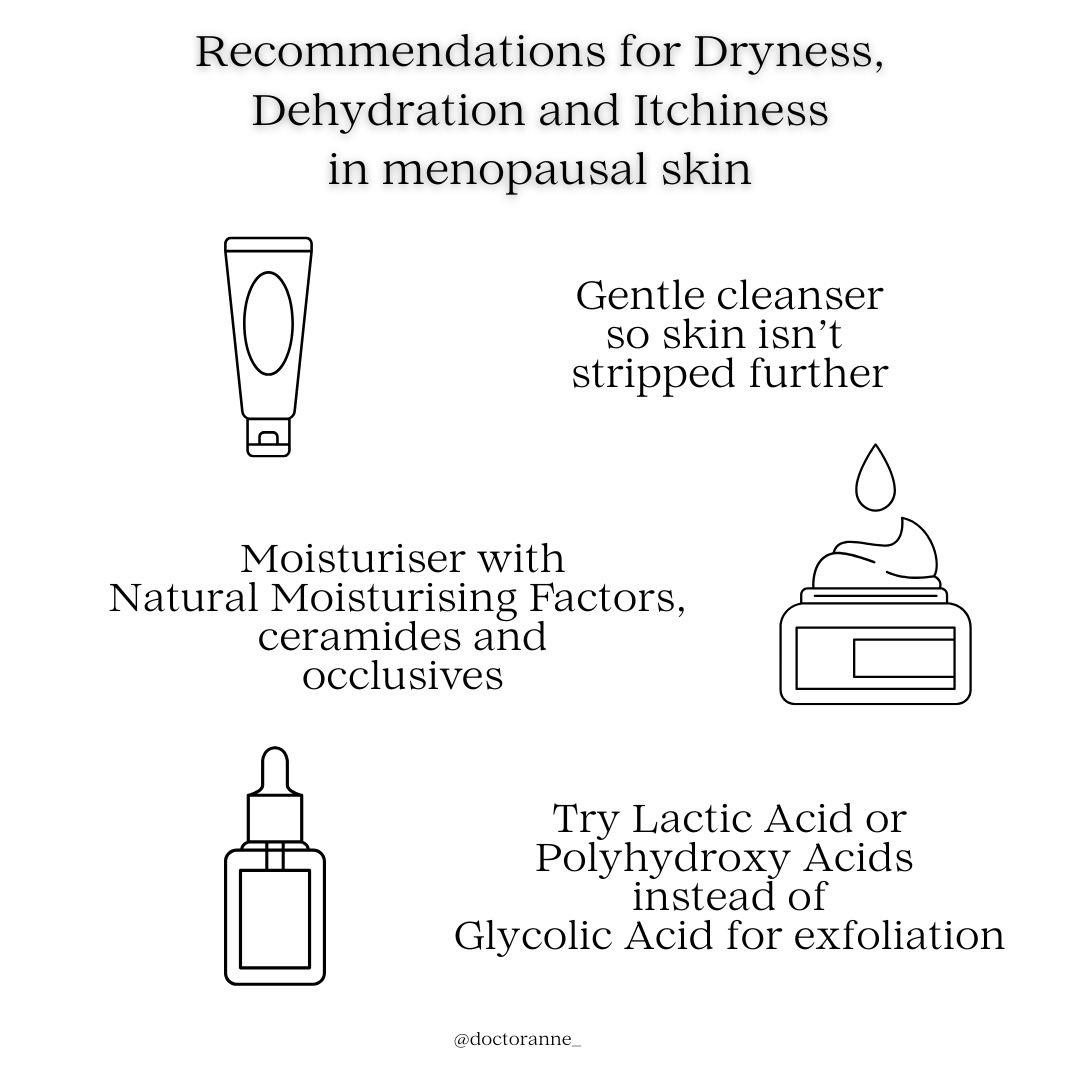
Dryness, dehydration and itching
You might feel that your skin is drier than usual, more prone to dehydration and be more itchy than you are used to. There are two main reasons for the dehydration:
- Less Natural Moisturising Factors, so less that holds the water in the skin, and
- increased evaporation because of the impaired barrier function.
Both result in an increase of Transerpidermal Water Loss or TEWL.
The dryness comes from the changes in the skins lipid layer, with a change in amount and in structure of ceramides present. And the itching is both due to the dryness, but also due to the impaired barrier, as it gets easier for irritants and pathogens to get under your skin, figuratively speaking.
To address all three, you need to focus on gentle and non stripping skin care to prevent aggravating the situation any further and on replacing Natural Moisturizing Factors, which are present in basically any moisturiser on the market, and in sealing in hydration with more occlusive products containing ceramides and other skin lipids.
If your skin is flaky, don’t immediately reach for an exfoliant, but try using a moisturiser first. Often that will help counteract the flakiness without irritating the skin any further. If you want to exfoliate against the dullness, try a Lactic Acid or even Polyhydroxy Acids instead of high strength Glycolic Acid, as it is often better tolerated by dry and irritated skin. (More info: The different exfoliating acids in skicare explained)
Drinking more is beneficial as it is healthy to be adequate hydrated, but won’t affect skin hydration much and has no linear effect – after you reach a certain level, you only need to pee more if you drink more. (More info: Can you drink your way to good skin?)

Wrinkles, sagging and loss of firmness
Addressing dehydration will help with skin creepiness and fine lines, but you’ll notice deeper lines forming that aren’t reversible with that. We all age differently depending on our genetics and bone structure, so for some wrinkles are a bigger concern, for others (myself included) the sagging and jowls. Both have the same root cause though, loss of collagen and elastin.
Now here is the thing: Topical skincare can only do very little there (yes, even prescription Tretinoin – it helps some, but won’t reverse time), so focus on prevention through first and foremost good sun protection and then on whatever we have that promotes collagen. Antioxidants like Vitamin C for example and the retinoids I already mentioned.
More experimental ingredients you can incorporate in your routine are peptides (especially copper peptides and Matrixyl) or maybe things like Growth Factors (but these are quite experimental). (More info: The benefits of peptides in skincare explained and The benefits of Growth Factors in skincare explained)
I often get the question why I don’t explicitly mention high strength Glycolic Acid peels here: because I think that to have an effect on collagen production, you’ll probably need to go in office for them. Which is true for most things that stimulate collagen as a procedure: Radiofrequency, Ultrasound, Microneedling – you can get all that for at home, and these devices might have an effect when used consistently, but your best bet is to see a professional. They also have the option for collagen inducing injectables.
Same goes for deep wrinkles, going in for in office treatments will have the most noticeable effect. Here the prevention method available to professionals is Botox and similar injectables but of course anything that stimulates collagen will help soften existing wrinkles as well.
I personally have not yet had any in-office treatments (which I sometimes regret when I look in the mirror and sometimes feel very good about), but I don’t think there is a right or wrong decision here. You simply must decide if you as individual want to spend money and time on that or if you are willing to accept the changes as part of getting older.
I use about every at home device there is, which is my form of compromise I guess. (More info: Two years of using at home devices – my experience)
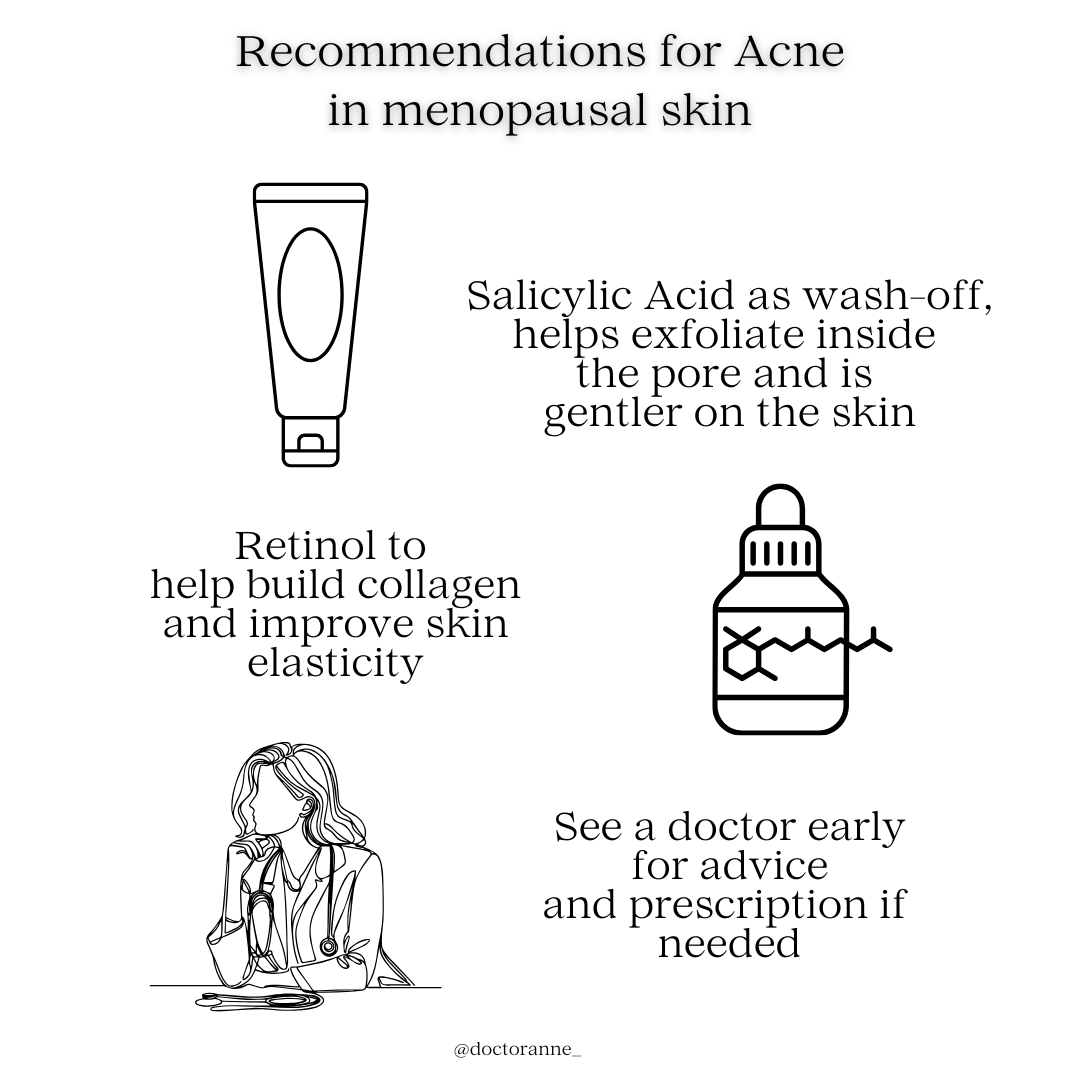
Acne and increased sensitivity
When you skin suddenly looks like you switched places with your teenage children, that as well can be blamed on the hormonal changes you (and them!) are going through. Even those that were blessed with blemisch free skin all their life might now wake up to painful cystic spots – life is full of surprises.
Treatment is the same as it is for teenagers, but different. Read: same basic ingredients, but in a much gentler formulation due to the increased sensitivity the skin shows.
There are different factors for the formation of acne (More info: Acne basics explained) that can be individually addressed:
- clogged pores due to improper desquamation
- increased sebum production
- bacteria causing inflammation.
The treatment of choice is exfoliation inside the pores with Salicylic Acid, for more mature skin often as a wash off rather than a leave on formula. Retinoids help with improved cell turnover and sebum regulation and, depending on the severity of your acne, Benzoylperoxide – usually used as spot treatment in mature skin – or topical or oral antibiotics to reduce bacteria and calm inflammation can be used.
There is also the option for oral treatment with spironolactone, but that just like antibiotics and Tretinoin are prescription and require a dermatologist consultation.
The main challenge here is to effectively treat the acne while at the same time being extra gentle, as the skin now can take much less than teenage skin can. But don’t despair, it is possible to find that middle ground.
As someone that has struggled with acne from the age of 12 until now at age 46, my routine has been adapted numerous times in the last 34 years.
Very important: Seek professional help early! Acne is a medical condition and once it reaches a certain degree of severity shouldn’t be experimented with at home.
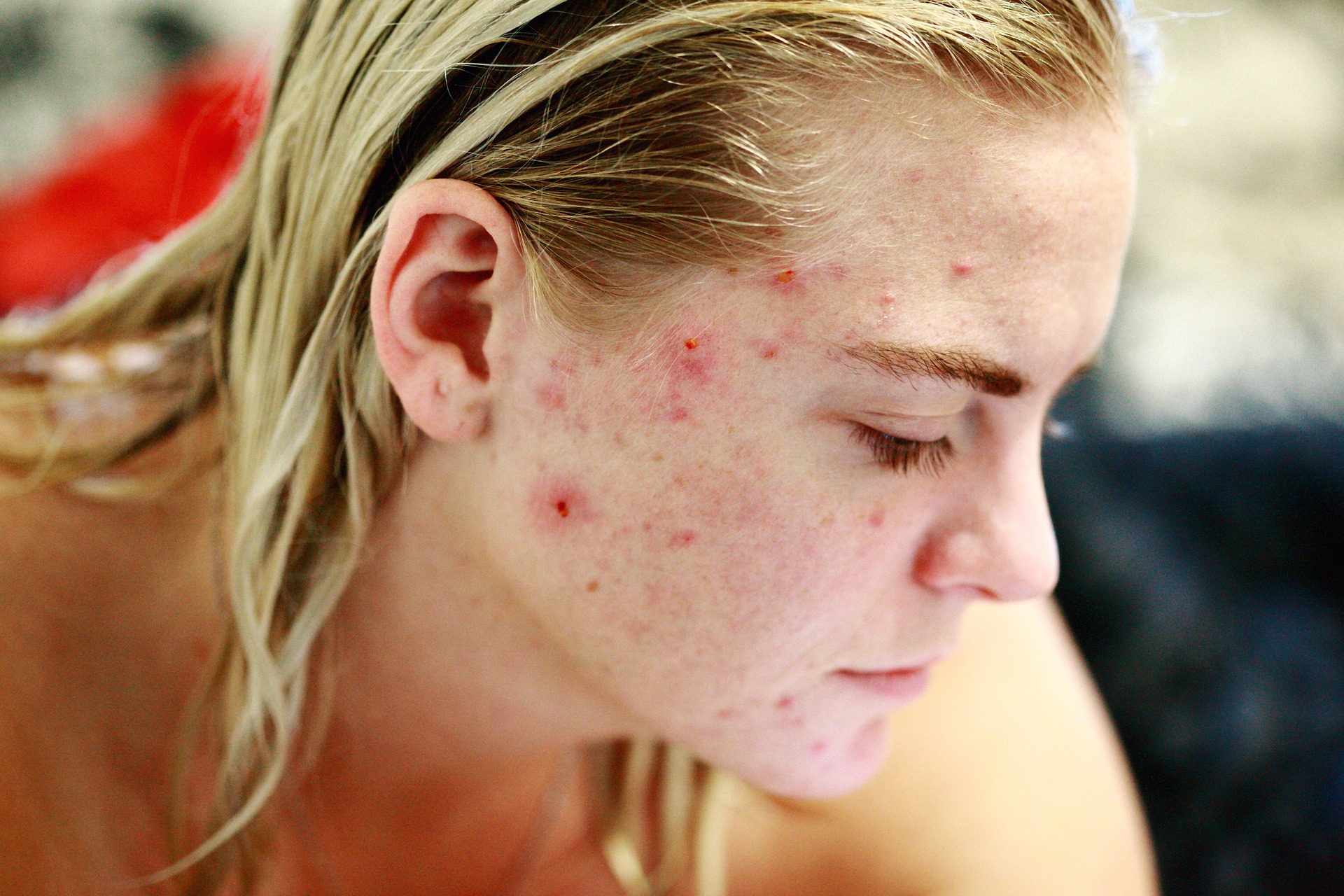
Image by Alexander Grey from Pixabay
What about Hormone Replacement Therapy and topical estrogen creams for the skin?
Is it possible that Hormone Replacement Therapy (HRT) affects the changes in the skin? Yes.
Should you get HRT for that? No.
HRT is a medication that, when appropriately used, can be very beneficial for the right person. It can also be absolutely unhelpful for the wrong person. In terms of its effects on the skin changes that come with menopause, we had a few observational studies suggesting positive effects on the face. That was however not reliably shown in randomised trials that followed these observational studies. As there are different regimens and doses that get summed up under the term “HRT”, that still doesn’t tell us if it will or won’t work, maybe there is a regimen that does.
But if you should go on HRT is a very individual decision you should discuss with your gynaecologist – assuming you have found one that is competent in this area, which can take a little time – and that is influenced by many different things, out of which your skins collagen production is the least important. If I for example were to discuss HRT with my doctor, we would talk about my family history of estrogen sensitive breast cancer, my family history of osteoporosis, my family history of cardiovascular disease, my symptoms, my age when the symptoms started, the severity of the symptoms and different lifestyle factors, and then would come to a conclusion based on that. My skins collagen levels wouldn’t even be considered.
The current surge of “every woman needs HRT or they are missing out big time” we see in social media annoys me just as much as nontoxic skincare stuff. It is a nuanced topic that needs a nuanced approach. (Other than nontoxic skincare, that is not nuanced, but just fear mongering).
Topical estrogen creams are a whole different thing. Do I think they work? And if I do, do I think they are safe to use for everyone? And what do I think about using your vaginal estrogen gel on your face to kill two birds with one stone? If you are interested in that, leave me a comment below and I will dedicate a post to that, it is too much to cover today.

Picture credit: Canva
Which ingredients are beneficial for the skin during menopause
Quite frankly, the ingredients and products I recommend during menopause aren’t that different to what I recommend all the time:
- sun protection with a high UVA rating,
- gentle cleansers,
- antioxidants like Vitamin C,
- a retinoid and
- a moisturiser adapted to your skins needs featuring Niacinamide if your skin agrees with that as well as Natural Moisturizing Factors. (More info: The benefits of Niacinamide in skincare explained and The benefits of Natural Moisturising Factors in skincare explained)
Yes, go to town with your peptides and Growth Factors and your at home devices if you don’t want to do in office procedures, but only if you have the other ones incorporated already, as they are what will move the needle most.
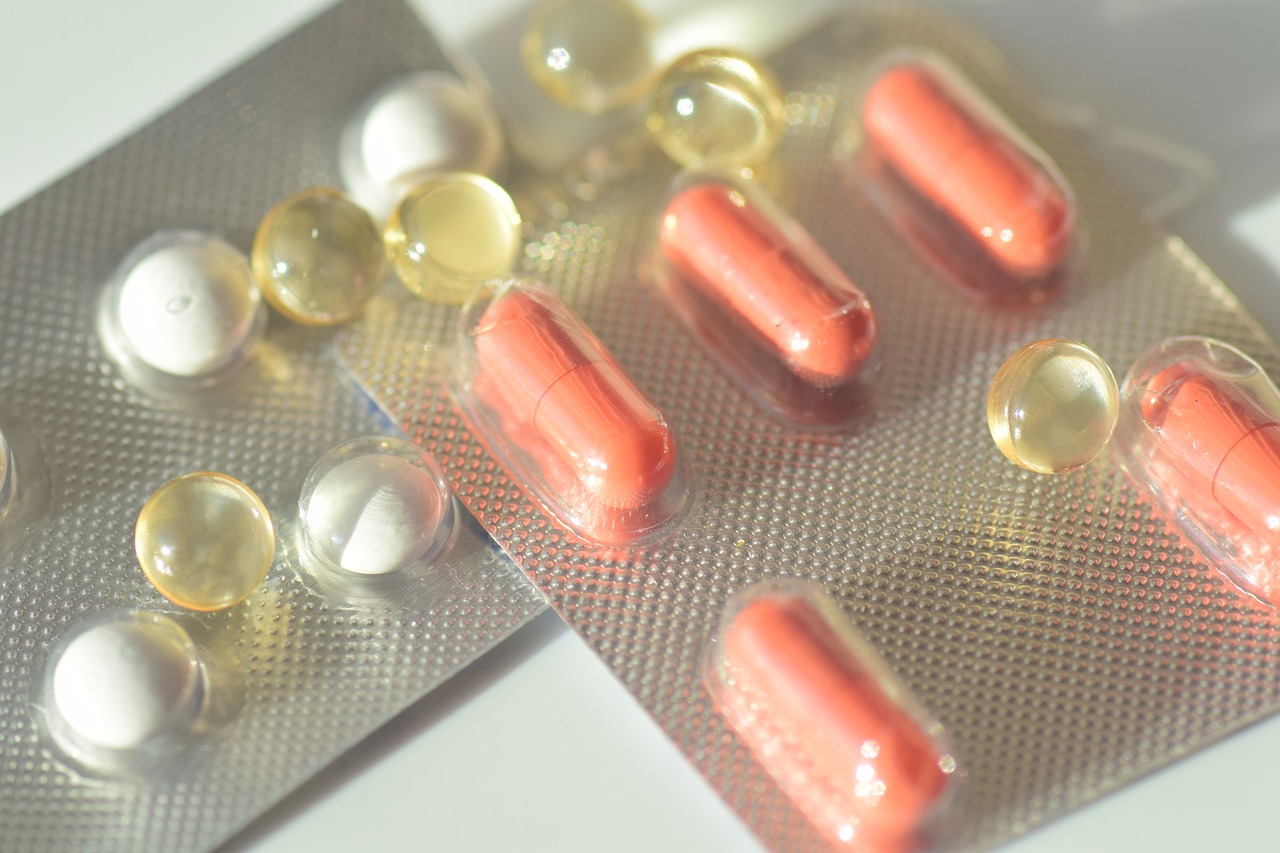
Image by Leopictures from Pixabay
Are there supplements I recommend?
Are there supplements I recommend you take when entering menopause and the years after that? Short answer: No.
I don’t believe in supplements outside substituting a deficiency diagnosed by a qualified person.
But for full transparency, here is everything I take in addition to eating a balanced diet:
- I take magnesium because I work out a lot and am prone to muscle cramps when my muscles are fatigued – loosely related to menopause and skin as I have had his for years already, but resistance training gets even more important as we get older and working out might improve your skins quality.
- I take Vitamin D because I have been diagnosed with Vitamin D deficiency around two years ago – not really related to perimenopause and to skin only indirectly through avoiding sun exposure.
- I have recently started taking Melatonin at night because for the first time in… ever I struggled to fall asleep and to sleep through the night not only for a few days, but for weeks. These struggles might be related to menopause and lack of quality sleep will for sure affect the skin.
- I take collagen powder with my morning tea. I have a whole post on collagen powder and the data body we have here, but in short: there is no evidence that it will improve skin or have other beneficial effects. But as it is a source of protein, which I struggle to eat enough of anyway, and has no known side effects, I decided to give it a shot. Around one year later I can’t say I noticed visible changes, but maybe it is preventative. Or maybe it is a waste of money.
I would stay away from any supplement containing a blend of herbs and targeting people entering menopause as there have been adverse outcomes related to those in the past.

Should you buy specialised menopause skincare brands?
Do we need skincare brands specifically targeting menopausal skin? No!
Just another form of pink tax as we are at an age where we are welcome consumers with a good income and less hesitation to spend it. Or maybe not pink, but … what is the appropriate color? Purple to mark the transition into our years of wisdom?
You need gentle skincare, but there is an abundance of that on the market already. If the brand speaks to you in terms of packaging and has appropriate price levels, by all means go for it. But if they sell you a nice moisturizer for triple the price just because they slapped the trigger word “menopause” on the jar, it is a hard pass.
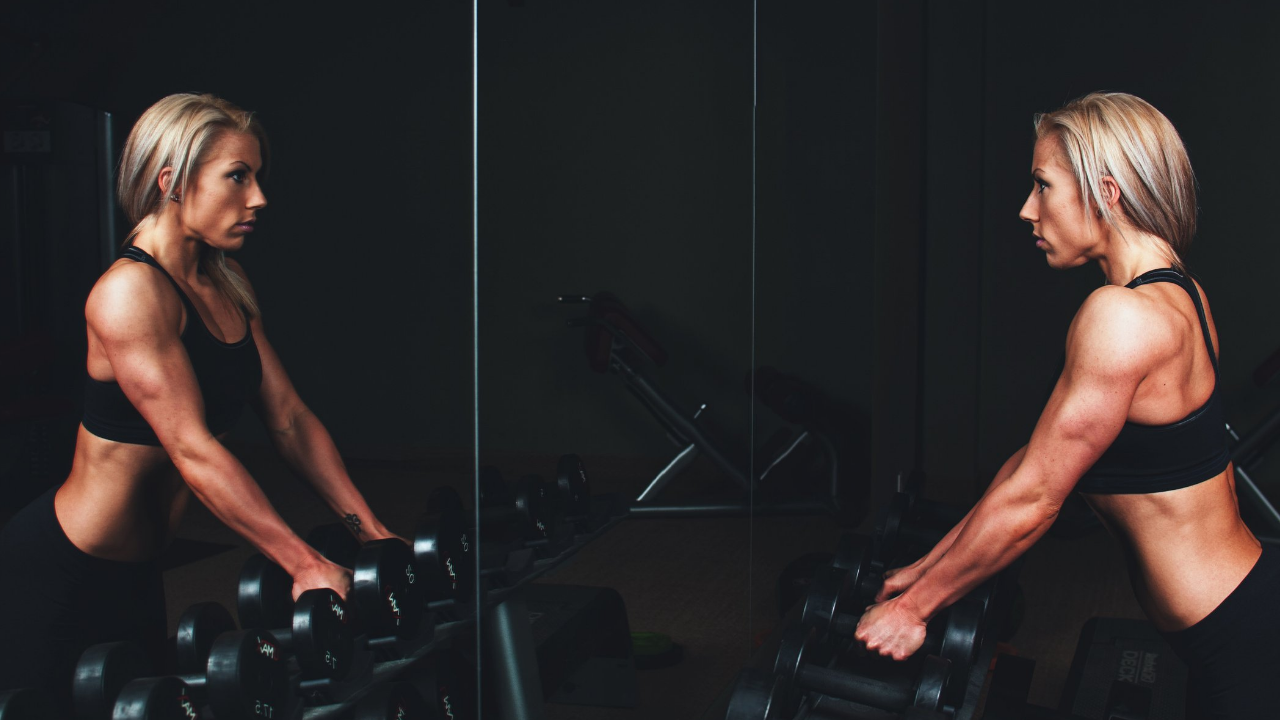
Does lifestyle affect how your skin behaves during that period?
How about your lifestyle choices, do they affect your skin during perimenopause and in menopause? Yes, just like they do during the rest of your life, although I admit you can get away with way more in your 20s than you can in your 50s.
Sun exposure, smoking and lack of sleep will speed up the age related changes in your skin, so if possible, stop them. There are also indicators that regular resistance training might slow down collagen loss and improve mitochondrial function, keeping the skin looking younger for long. I have a separate post on that here, but again, it is just pointers in that direction, no solid evidence. But with the multitude of benefits of resistance training on cardiovascular health, bone density and mental health, you will certainly benefit from incorporating it into your life in one way or another.
Same goes for eating a balanced diet full of vegetables and with enough protein. It has a multitude of benefits for you and will most likely also positively influence your skin. (More info: The best foods to eat for healthy skin)
I admit these are not the most exciting things to do, but they are tried and tested, so why sleep on them?

Shop my favorite skincare here
Don’t forget to check out the Discount Code Page on top if you want to save some money on your next skincare purchase, or click here to let me build a personalized skincare routine for you.
If you want to get more involved and pick my next topics or see exclusive behind the scenes content, don’t forget you can head over here and become a YouTube Channel Member!
